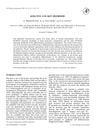Overexpression of Human Keratin 16 Produces a Distinct Skin Phenotype in Transgenic Mouse Skin
September 1995
in “
Biochemistry and Cell Biology
”
TLDR High levels of human keratin 16 in mice cause skin lesions and abnormal skin development.
The study investigated the effects of overexpressing human cytokeratin 16 (K16) in transgenic mice to understand its role in skin physiology. K16 is typically expressed in postmitotic keratinocytes and is upregulated in hyperproliferative or abnormally differentiating stratified squamous epithelia, particularly at wound edges. Transgenic mice with low K16 expression appeared normal for 6-8 months, while those with high expression developed skin lesions within a week of birth, coinciding with fur emergence. These lesions began with keratin filament reorganization in the hair follicle's outer root sheath and spread to the proximal epidermis, leading to thickened epithelia, altered keratinocyte structure, and abnormal keratinization without cell lysis. The findings suggested implications for epithelial differentiation, genodermatoses, and wound healing.

